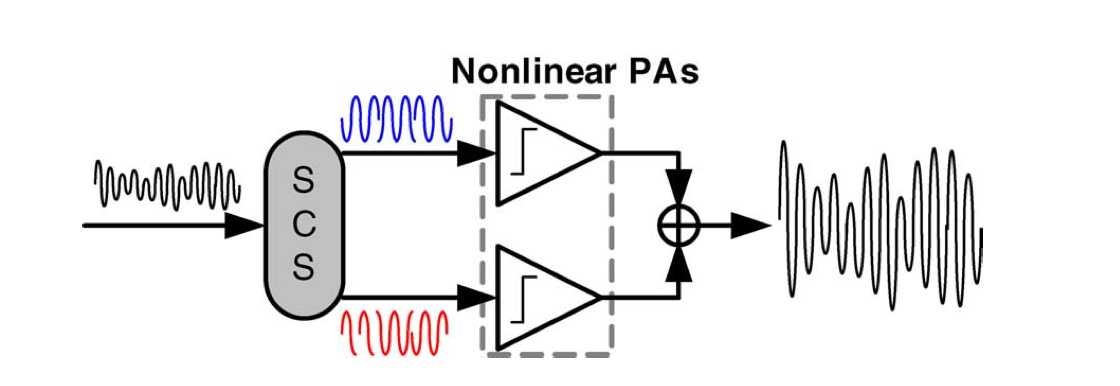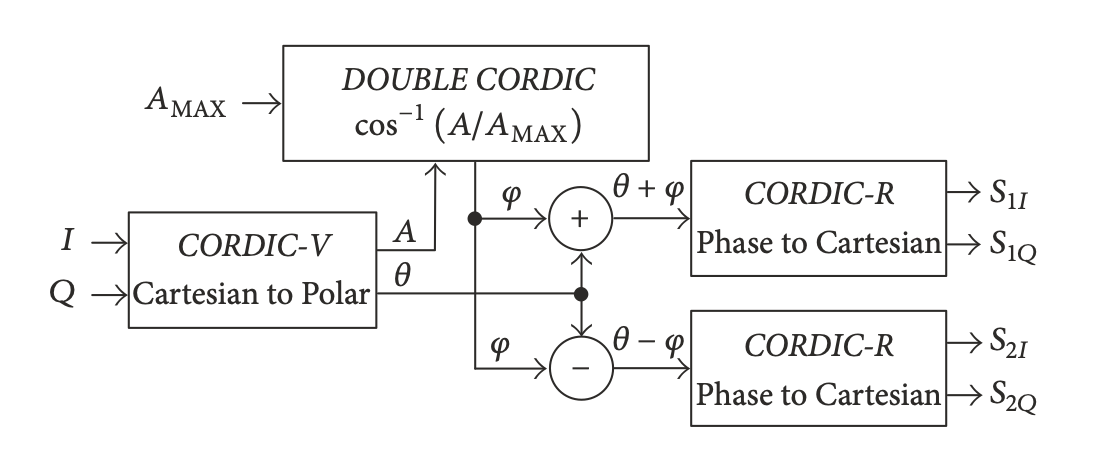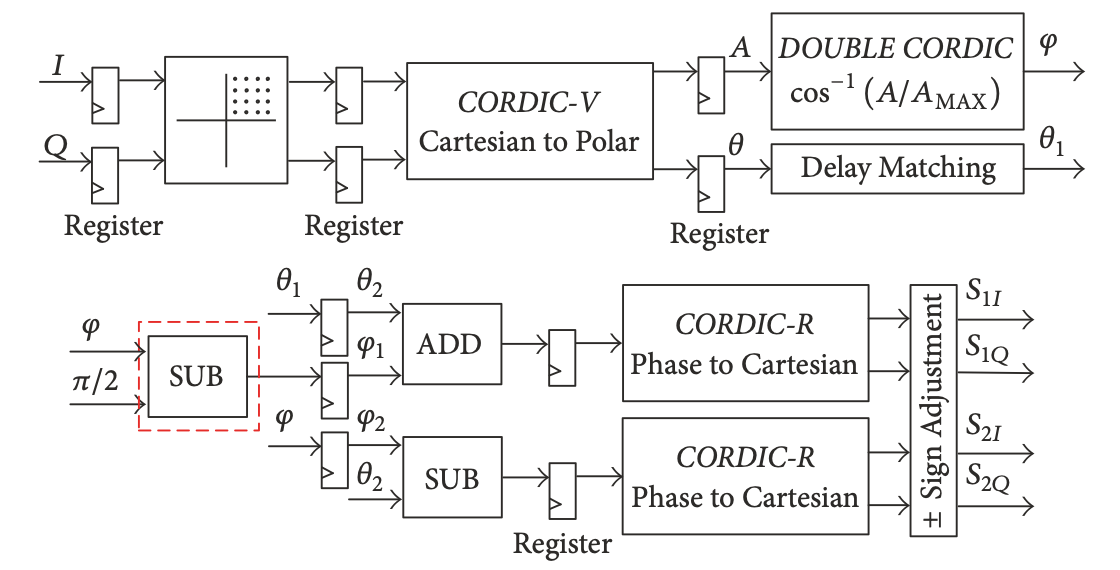LINC (Linear amplification with nonlinear components) 是一种使用非线性元件进行线性放大的功率放大器系统,可以在获得高线性度的同时获得高效率。其结构如下图所示:

LINC 的基本思想是使用 SCS (signal component separator) 将相位幅度调制的信号转为两路相位调制信号,然后再通过两个高效率的非线性功率放大器放大,最后通过组合两路信号获得原始信号的放大后的信号。
在 LINC 系统中,需要使用到 SCS,其实现可以使用模拟的方案,也可以使用全数字的方案。
本文记录了全数字 SCS 的实现方法。
基于 CORDIC 算法的 SCS 原理

基于 CORDIC 算法的 SCS 原理图如上图所示,基带信号 I Q 经过 CORDIC-V 模块,从笛卡尔转换到极坐标,得到振幅 \(A\) 和相位 \(\theta\),振幅 \(A\) 经过 DOUBLE CORDIC 模块,进行 \(\rm{cos}^{-1}(A/A_{MAX})\) 的运算,得到 \(\varphi\),相当于把振幅信号转为相位信号。然后通过两个 CORDIC-R 模块,分别对 \(\theta + \varphi\) 和 \(\theta - \varphi\) 做相位到笛卡尔坐标的转换,得到四路调相信号:\(S_{1I},S_{1Q},S_{2I},S_{2Q}\)。
具体计算过程如下:
假设基带信号 (baseband signal) 为: \[ S_b(t)=S_i(t)+jS_q(t) \] 则频带信号 (transmitted signal) 可以表示为: \[ S(t)=Re\left\{ (S_i(t)+jS_q(t))e^{j\omega _ct} \right\}=A(t)\cos\left(w_{c}t+\theta(t)\right) \] DOUBLE CORDIC: \[ \phi(t)=\cos^{-1}\left(A(t)/A_{\max}\right) \] CORDIC-R: \[ S_{1I}(t) = 0.5 A_{max} \rm{cos}[\theta(t)+\phi(t)] \]
\[ S_{1Q}(t) = 0.5 A_{max} \rm{sin}[\theta(t)+\phi(t)] \]
\[ S_{2I}(t) = 0.5 A_{max} \rm{cos}[\theta(t)-\phi(t)] \]
\[ S_{2Q}(t) = 0.5 A_{max} \rm{sin}[\theta(t)-\phi(t)] \]
混频: \[ S_1(t)=S_{1I}(t)\rm{cos}(\omega _c t)-S_{1Q}(t)\rm{sin}(\omega _c t) \]
\[ S_2(t)=S_{2I}(t)\rm{cos}(\omega _c t)-S_{2Q}(t)\rm{sin}(\omega _c t) \]
\[ S(t) = S_1(t)+S_2(t)=A(t)\rm{cos}[\omega _c t+\phi(t)] \]
SCS 的原理图

SCS 原理图如上图所示。其中基带 I Q 信号为 64QAM 信号。为了简化算法实现的复杂度,首先将 I Q 信号变换到第一象限,并记录下 I Q 信号原本的象限,最后在输出的时候做符号调整就可以了。上图红框中将 \(\varphi - \pi/2\),原因是因为在实际的设计过程中发现 \(\theta + \varphi\) 会大于 \(\pi /2\),为了避免溢出而将其减了 \(\pi /2\),因此在进行符号调整之前: \[ S_{1I}(t) = 0.5 A_{max} \rm{cos}[\theta(t)+\phi(t) - \pi/2] \]
\[ S_{1Q}(t) = 0.5 A_{max} \rm{sin}[\theta(t)+\phi(t)-\pi/2] \]
Matlab 行为级仿真
在进行 MATLAB 仿真时,为了让仿真结果和真实结果更加接近,进行了每一步计算过程都进行了浮点转定点数的操作。
仿真结果
64QAM 基带信号:
64QAM 频带信号:
64QAM 星座图:
对基带信号进行 SCS 运算得到的 \(S_{1I},S_{1Q},S_{2I},S_{2Q}\) 信号:
将 SCS 后的基带信号与载波相乘:
可以看到两路信号 S1 和 S2 是两路恒包络的调相信号,说明 SCS 模块实现了将原来的调幅调相信号转为两路恒包络的调相信号。
两路信号 S1 和 S2 合成:
可以看到合成后的信号与原始信号一致,说明在 SCS 的过程中信号的信息没有丢失。
Matlab 代码
1 | % main.m |
1 | % random_msg.m |
1 | % Signal_Adjusment_quad.m |
Reference
[1] CORDIC-Based Multi-Gb:s Digital Outphasing Modulator for Highly Efficient Millimeter-Wave Transmitters
[2] A Sub-mW All-Digital Signal Component Separator With Branch Mismatch Compensation for OFDM LINC Transmitters
[3] A Low Power All-Digital Signal Component Separator for Uneven Multi-Level LINC Systems





